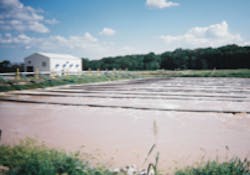No Longer for the Birds
The private wastewater treatment facility at Brakebush Brothers Inc.—a chicken products manufacturing plant in Westfield, Wis.—was good at removing breading and other byproduct solids from waste flows. But the rural plant—a “further processing” (post-butchering) facility—produces uncommonly heavy loads of fats, oils and grease (FOG) that were taxing the aerobic treatment process in its secondary treatment lagoon. It needed to introduce more oxygen and mixing into the plant’s lagoon to do an efficient, effective treatment job.
Brakebush waste flows are pumped to a 250,000-gal filtration tank, which provides pretreatment of the waste flows that consist of screening solids and skimming fats and oil from the surface. After pH control is performed, three dissolved air flotation clarifiers provide primary treatment of the 400,000-gpd flow. A single 3.1 million-gal lagoon provides secondary treatment.
The challenge
Bucky Walters, the facility’s lead wastewater operator, was having difficulty maintaining dissolved oxygen levels in the lagoon during cold weather with his existing surface aerators. During the often-brutal Wisconsin winters, the lagoon experienced freeze-outs. The old aerators would flip over from ice displacement, causing a decrease in the amount of oxygen delivered to the basin and, thus, a reduction in the quality of treatment.
Even when it was functioning, the aeration process was not powerful enough to meet the plant’s treatment needs.
Another development would soon overwhelm the lagoon’s aeration capacity: Brakebush was about to significantly increase production. The current system utilized splash aerators, the performance of which was simply inadequate to meet the oxygen demands of the treatment process. Additionally, the combined 475 hp of the aerators were eating electricity like it was going out of style. There was no more putting it off: It was time to upgrade the aeration system.
The project
After spending two months researching viable aeration replacements, Utilities Manager David Meyer consulted with Neenah-based architectural engineering firm The McMahon Group about technical specifications. Once they had identified the facility’s needs, Meyer contacted Energenecs Inc., an industrial water pollution control equipment wholesaler in Cedarburg, Wis., to identify potential vendors. Energenecs specified Environmental Dynamics International (EDI), which designs and manufactures water aeration systems at its Columbia, Mo., headquarters. EDI offered a fine-bubble, high-efficiency diffused aeration system that could be configured to the Brakebush plant’s specific requirements.
The team settled on EDI’s floating lateral system with FlexAir 88S diffuser assemblies, outfitted with Magnum diffusers. The upgrade installation took less than a week and was performed by Lee’s Contracting of Little Chute, Wis. To prevent any disruption in treatment during the upgrade, the plant stayed online by leaving the old aerators in place while new laterals were installed. Old aerators were removed as each new floating lateral came online.
The results
The FlexAir system provides the ability to perform superior oxygen transfer through the production of ultra-high-density micro-bubbles while running on less than half the power required by the plant’s old system—the total operating power requirements were dropped to 200 hp with the new system.
A year after the original upgrade, some settling was noticed around the lagoon’s edges, as evidenced by a great deal of clear water over solids in the shallows. Meyer and Walters realized they had undersized the equipment scope and needed to extend the laterals into the shallower edge areas with what they call a “corner system.” EDI responded with a turnkey design for the additional equipment requirements with the new system installed by its Aeration Works division.
The total cost for the aeration upgrade project was minor when compared to the additional profits generated by the manufacturing plant’s increased production. Much of the capital cost was regained through the significant electricity savings provided by the system’s performance.
